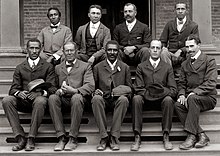Charles W. Green
Charles W. Greene | |
|---|---|
 Greene in bowtie next to George Washington Carver (bottom row second from left) | |
| Born | c. 1849 Gatesville, North Carolina |
| Education | Hampton Institute |
| Scientific career | |
| Fields | Agriculture, Real estate development |
| Institutions | Tuskegee Institute |
Charles Walter Greene (c. 1849-1926) was the first teacher of agriculture at Tuskegee Institute and the second head of the Agriculture Department at Tuskegee. He was a graduate of Hampton Institute and classmate of Booker T. Washington.[1] He took over as Tuskegee Institute's farm manager in June 1888.[2] The school had mostly trained teachers up until then. George Washington Carver was recruited to the Agriculture faculty in 1896.[3]
Greene was born in Gatesville, North Carolina in about 1849.[4] Although several years older, Greene was a classmate, friend, and roommate of Booker T. Washington at Hampton Institute.[5] Each had a prominent role in the program for their graduation in 1875.[6]
Greene came to work at Tuskegee in June, 1888. He went out to rural areas to teach farmers about newly identified and other improved agricultural practices, preceding the development of extension services for Black farmers.
Before the turn of the century, Washington instructed Greene to acquire property to develop a village area that would be entirely owned and operated by "Negroes" and demonstrate their capability and establish economic independence. The district was formally designated in 1901 and named Greenwood, entirely apart from the school. Following Washington's 1905 visit to Arkansas, Indian Territory and Oklahoma, and his speech in Tulsa suggesting the Tuskegee Greenwood District as an example of what he was recommending, Tulsa named its Negro-owned district Greenwood in 1906.
In 1910, Greene accompanied Washington on his visit to North Carolina (one of five such public tours surveys Washington made from 1908 to 1912 to southern states and Texas), to encourage economic development, independence, self-help, and race pride. In 1940, a plaque at Tuskegee Institute was unveiled to commemorate Greene's service.[4]
He wore a bowtie and glasses.[7] William James Edwards was one of his students.[8] William Henry Holtzclaw also studied under him before moving on to the printing department.[9] Martin A. Menafee also worked on the farm.[10] George Washington Carver was recruited to work in the Agriculture Department in 1896.[11]
References
[edit]- ^ Jones, Allen W. (1975). "The Role of Tuskegee Institute in the Education of Black Farmers". The Journal of Negro History. 60 (2): 252–267. doi:10.2307/2717374. JSTOR 2717374. S2CID 149916547.
- ^ "The Southern Workman". Hampton Institute Press. January 27, 1901 – via Google Books.
- ^ "HISTORIC RESOURCE STUDY tJUSKEGEE INSTITUTE NATIONAL HISTORIC SITE TUSKEGEE, ALABAMA" (PDF). npshistory.com/. Archived (PDF) from the original on 2016-04-14. Retrieved April 22, 2020.
- ^ a b "Charles W Kelly & Charles W Greene Plaque (Greenwood dedication)". December 7, 1940. p. 2 – via newspapers.com.
- ^ "The Tuskegee News -- 09/28/2000, Page 8". tkg.stparchive.com. Retrieved 2020-04-22.
- ^ Washington, Booker T.; Daniel, Pete R.; Harlan, Louis R. (October 1972). Booker T. Washington Papers Volume 2: 1860-89. University of Illinois Press. p. 98. ISBN 978-0-252-00243-4.
- ^ Hersey, Mark D. (May 1, 2011). My Work Is That of Conservation: An Environmental Biography of George Washington Carver. University of Georgia Press. ISBN 9780820339658.
- ^ Edwards, William James (December 23, 2019). "Twenty-Five Years in the Black Belt". Good Press – via Google Books.
- ^ Holtzclaw, William Henry (April 18, 1915). The Black Man's Burden. Neale Publishing Company. ISBN 9780837129327 – via Google Books.
- ^ "Tuskegee and Its People by Booker T. Washington: Martin A. Menafee of Denmark, South Carolina". www.online-literature.com.
- ^ McMurry, Linda O. (1981). George Washington Carver, Scientist and Symbol. Oxford University Press. ISBN 0-19-502971-2.
